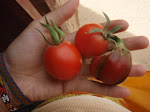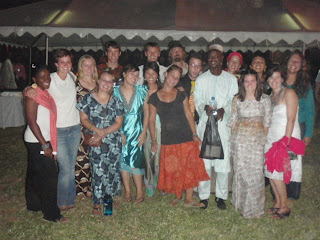
Habi gave me some really cool henna at the end of Ramadan.
1/27/08
 want. Then you stick the strip of tape along the side of your foot or on your hand, and put the henna paste on top of it. It's also typical to dye the tips of your fingers and the palm of your hand. Next, paste in place, you tie plastic bags over your hands and feet, to keep in the moisture. Then you sit and sit and sit, until your skin becomes a satisfactory orange. This takes an hour or two. If you have really thick callouses, the color shows up very well; I guess the dead skin can soak it up better. Next, you untie yourself, and wash off all of the leafy paste. You mix wood ash and ammonium salt with water, which makes a black, smelly paste. This gets smeared on the same places, you get tied up again, and then you sit some more. Eventually your henna will turn black! Very cool.
want. Then you stick the strip of tape along the side of your foot or on your hand, and put the henna paste on top of it. It's also typical to dye the tips of your fingers and the palm of your hand. Next, paste in place, you tie plastic bags over your hands and feet, to keep in the moisture. Then you sit and sit and sit, until your skin becomes a satisfactory orange. This takes an hour or two. If you have really thick callouses, the color shows up very well; I guess the dead skin can soak it up better. Next, you untie yourself, and wash off all of the leafy paste. You mix wood ash and ammonium salt with water, which makes a black, smelly paste. This gets smeared on the same places, you get tied up again, and then you sit some more. Eventually your henna will turn black! Very cool.In cities, there are more modern ways to get henna done. I just tried one new kind, which turned out so beautifully...I wish it could last longer! In this technique, a very creative, steady-handed, Mysterious Woman squeezes black goo onto your hands and feet, making gorgeous designs of your choosing. In my case, I just pointed at other women around and asked for designs like theirs. After said Woman has finished, you sit for a long time. No plastic bags required, a bonus side to this type of henna. Then, you wash off all of the black goo (what IS that black goo?), and think "oh my God it didn't work" because the designs are so faint. But wait! Mysterious Woman has another trick up her sleeve. Now, you stick your arms into a giant clay jar, which has burning coals in the bottom. The mouth of the jar is stuffed closed with cloth, so that all of the smoke stays inside and swirls around your hands. After a few additions of more smoky coals, your henna turns dark, delicious black, and you are awestruck by your sudden beauty.













